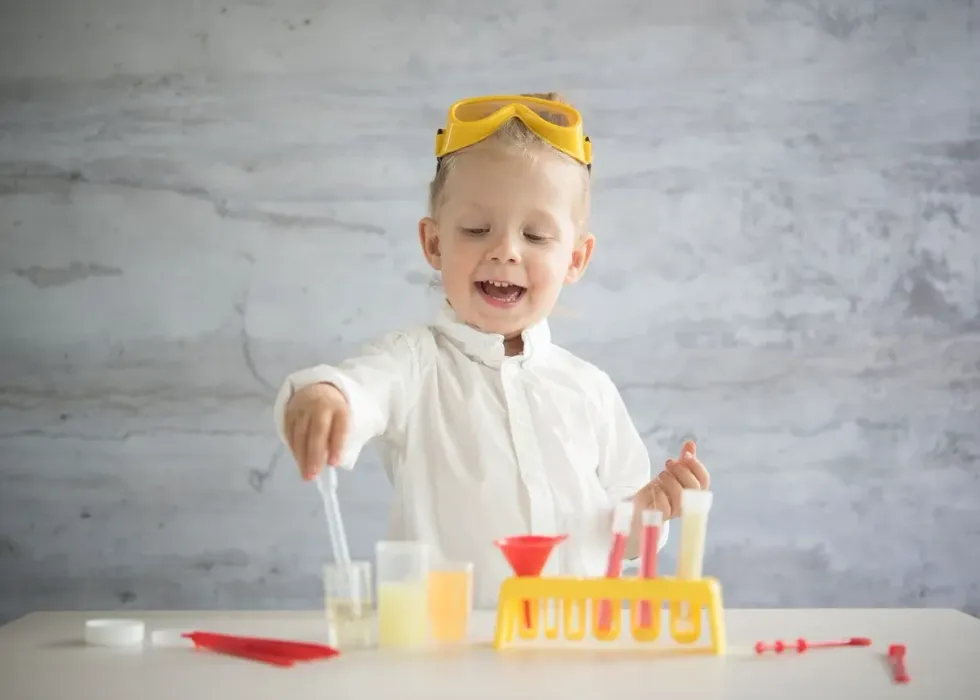One way kids get interested in science is through a barrage of “fascinating facts”, from TV shows, magazines and trivia books. Did you know that the air around a bolt of lightning is hotter than the surface of the Sun?
Or that there are 10 times as many stars in the sky as grains of sand in all the world’s beaches and deserts? But sometimes these “facts” aren’t quite true or, with a bit of nitpicking, can hold even more interesting depths.
We can all parrot the rule that “nothing can travel faster than light”, but there are intriguing exceptions.
We call a dog a dog, a cat a cat, and a human a human, but every creature is really an aggregate of different lifeforms. With some sideways thinking, you can even explain why the typical person does not have 10 fingers.
Use the following seven examples as discussion points with your kids, and see where it leads. For those with younger children, try these fun experiments, designed for preschoolers, or these for KS1 kids.
Half Of Your Body Is Not Human
Not been feeling yourself lately? It might be because half the cells in your body are not human.
The corners, surfaces and crevices of our bodies are stuffed with bacterial cells -- some harmful, some helpful, most neutral. Bacterial cells are much smaller than the cells that make up your tissues, and so there’s plenty of room to cram them in.
If you could somehow take a human apart and count the constituent cells individually, you’d find that about half are bacteria.
The same is true of any large animal. You could use this as a talking point with your kids. What is “a dog”.
Is it just the collection of canine cells, programmed from the dog’s DNA, or is it the dog cells plus the bacterial cells all together? It can all get very philosophical.
Some Things CAN Travel Faster Than Light

Einstein famously told us that nothing can go faster than the speed of light which, in case you need reminding, is a staggering 186,000 miles every second. But the dodge here is that this is light’s speed in a vacuum.
Light slows down when it passes through something. Both air and water retard it a little. But if you use exotic material, you can clip light’s heels to tortoise speed.
Using lasers, crystals and incredibly low temperatures, scientists can even bring a beam of light to a complete halt. Under such circumstances, you could run faster than the speed of light… if only you were allowed to run in a laboratory.
Water Is Rubbish At Conducting Electricity
Take a look in your bathroom. You won’t find a standard plug socket anywhere.
Quite probably, the light switch is also outside the door. That’s because the combination of water and electricity is bad news, and we’re all taught this from a young age. Oddly, though, water is a really, really bad conductor of electricity.
Pure water, that is. The liquid that comes out of our taps is actually a soup of impurities, and it is these impurities that pass on the electric charge. Take these out, and the pure water is an insulator rather than a conductor.
This is of little practical help, though. Even if you took your bath in distilled water, the impurities from your body would quickly turn it into a conducting fluid.
Astronauts Do Not Float In Zero Gravity

When you’re onboard the space station (as I’m sure you often are), there is no real ‘up’ or ‘down’, no walls, floor or ceiling. Astronauts do not appear to fall in any particular direction, but simply float where they are.
The situation is often described as ‘zero gravity’. Yet, surprisingly, astronauts on the space station still experience about 90% of the gravitational pull they would do on the Earth’s surface.
The space station, and everyone in it, are plummeting towards the planet at tremendous speed, thanks to gravitational attraction. Happily, they’re also travelling ‘sideways’ at immense speed, thanks to momentum gained on the initial rocket launch.
The two motions together mean they effectively fall around the curvature of the Earth, and never hit it. They appear to float for the same reasons that someone in a falling elevator would: they’re in freefall, albeit a freefall without end.
Sputnik Was NOT The First Artificial Object In Space
The launch of the Soviet spacecraft Sputnik in 1957 caused a sensation around the world. For the first time, an artificial object was circling around the planet.
But it wasn’t the first thing we’d put into space. Not by a long shot. The key word here is ‘orbit’.
It takes a great deal of energy (and a very big rocket) to reach the speeds needed for orbit. But you can send something straight up and down again (it’s called a suborbital hop) with more modest rocketry. The first to do this were German scientists during the Second World War.
A prototype of the V2 rocket first crossed the boundary into space on 3 October 1942 -- 15 years before Sputnik. Sadly, these rockets were intended (and used) as weapons, but they paved the way for more peaceful uses of space that came after the war.
Water Does Not Drain In Different Directions In The North And South Hemispheres
An old yarn would have us believe that draining water always spins clockwise if you’re somewhere south, like Australia, and anti-clockwise for those in more northern latitudes. The direction of the swirl reflects the direction the Earth is turning relative to the plug hole.
But it’s not true. The spin of the Earth can play games with the oceans and atmosphere, but has no visible effect on the scale of the kitchen sink.
The direction of spin will be determined by more local factors, like the shape of the basin, any existing movement in the water, bumps on the porcelain and even encrusted toothpaste. You can easily test this at home by seeing which way your own basins and bathtub drain.
Are they all consistent? Every time?
Fish Were Not The First Animals To Leave The Oceans
Go back 500 million years, and you’d have very little company on the land. At the time, almost all multicellular life was in the sea.
No plants, no animals -- though you might have found some fungus if you were lucky. In the popular imagination, this all changed when a particularly bolshy fish tried waddling up onto the shore in search of food.
It decided to stay, and its descendants became amphibians, reptiles, mammals and birds. Well, that’s all true, but the first fish to brave the land would have found it already populated.
The first creatures to emerge were probably forms of life somewhere between insects and crustaceans. They were making a terrestrial home for themselves at least 125 million years before the first fish had a go.
And Finally… Humans Don’t Have 10 Fingers
You might have 10 fingers, and so might everybody you know. But averaged over the whole population, the count is something like 9.95. Enough people have missing hands and fingers to bring the mean number down below 10. Oh, and that’s before you get on to arguments about whether thumbs should be counted or not.
See also
Science days out in the UK










